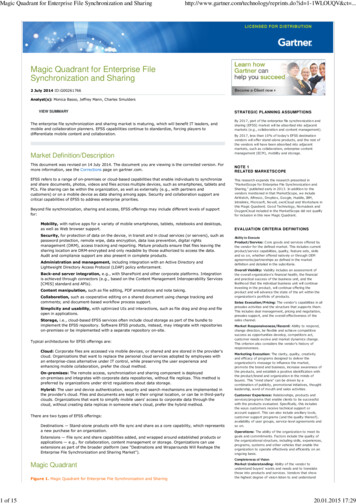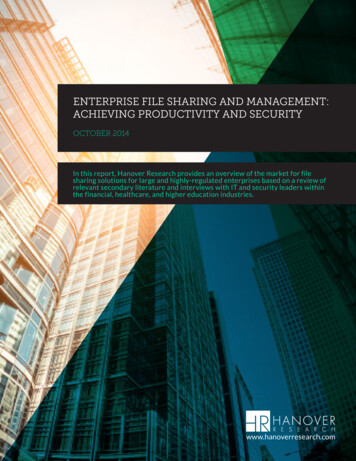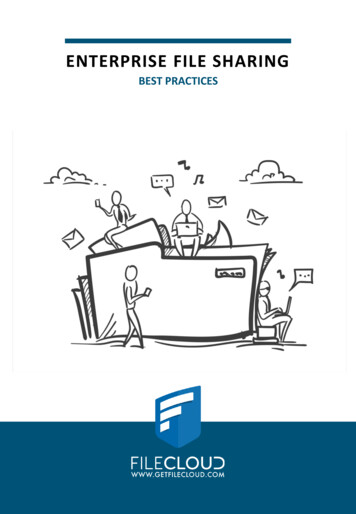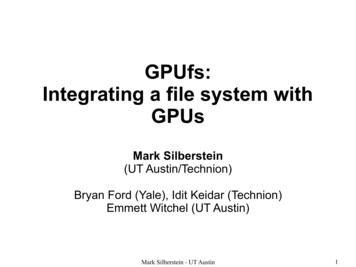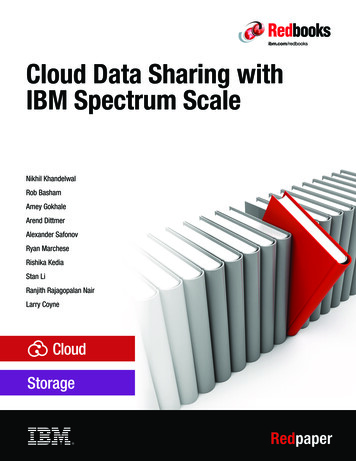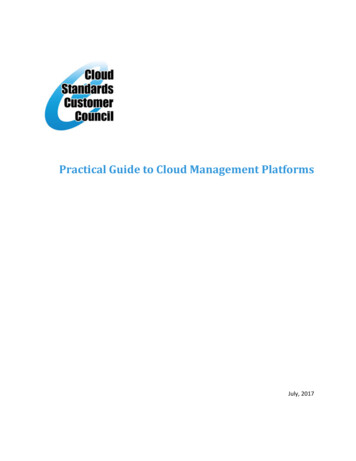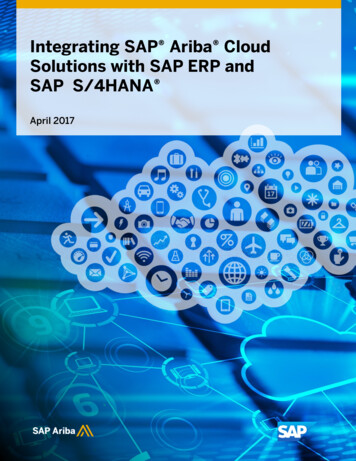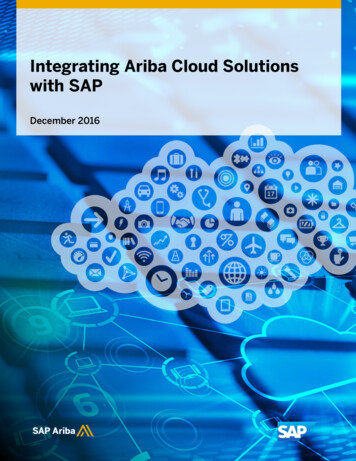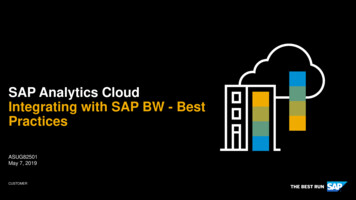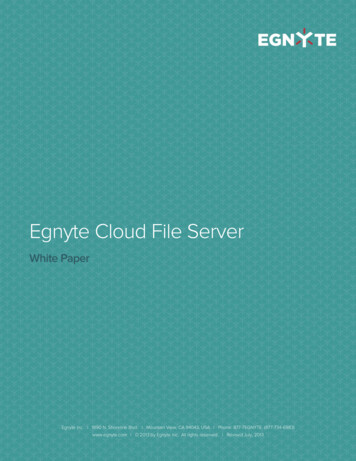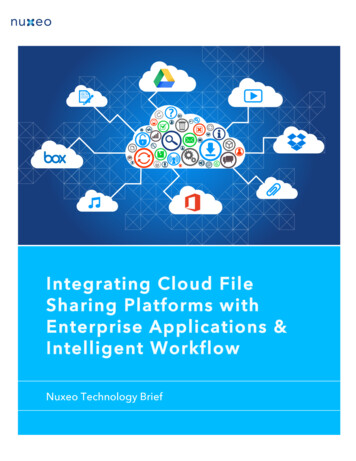
Transcription
Integrating Cloud FileSharing Platforms withEnterprise Applications &Intelligent WorkflowNuxeo Technology Brief
Going Beyond Simple File Sharing in the EnterpriseAdoption of collaborative technology in the workplace has skyrocketed over the last two years, driven to alarge degree by the capabilities of cloud-based storage and file-sharing platforms. Gartner projected thatby 2016 approximately 50 percent of large organizations will have deployed internal collaboration networkswith shared storage repositories and 30 percent of these networks will be considered as valuable as emailand telephones are today.As this trend continues, resulting in greater productivity for workgroups, IT leaders are seeking ways to takeadvantage of functionality offered by collaborative tools. One promising technique is to integrate cloud filesharing (CFS) platforms more deeply into business processes by means of enterprise content management(ECM) systems, digital asset management (DAM) systems, and other business systems. File-sharing tools domake the cloud as useful for storage, if not more useful, as a local hard drive. But, on the negative side, theshared file content contains minimal metadata and no built-in functionality for integration with otherbusiness applications.Enterprise application developers recognize that cloud file-sharing alone can’t deliver the full businessvalue of collaboration and they also realize that strategies that integrate CFS platforms deeply into companyprocesses can more effectively meet business objectives and empower work teams.Integrating Cloud File-Sharing Platforms to Enable Intelligent WorkflowCloud file-sharing (CFS) platforms have soared in popularity by making it easy for business teams tocollaborate on everyday work files—spreadsheets, procedure manuals, press releases, presentations, and soon. The largest drawback is that they typically don’t integrate well with mainstream business processes orECM systems. Sometimes classed under the category “file sync and share," leading CFS platforms includeGoogle Drive, Dropbox, Box, and Microsoft Office Online. Many offer cloud-based productivity apps, suchas Google Docs and Sheets, and Microsoft Word Online.In comparison, ECM platforms are ideal for architecting business applications that automate workflow andsupport vital business operations, but many of them are closed systems without native support for CFSplatforms. Establishing native connections between CFS and ECM platforms unlocks the benefits andstrengths of each approach and makes it possible to architect applications that automate workflow,enhance business operations, and improve collaboration across production pipelines, as explained in thispaper.Page 2 of 8
The Widening Range of CFS SolutionsThe availability of enterprise-strength CFS solutions gives companies new opportunities for collaborationand extended file sharing, and also opens the potential for linking shared assets to existing businessprocesses and deepening their value with embedded metadata. Gartner identified over 100 enterprise filesync and share (EFSS) vendors with product offerings in their EFSS solutions Magic Quadrant report on theEFSS market. Despite the growing popularity of this technology, more than three-quarters of companieshave yet to choose a solution. One factor that may be slowing adoption—despite the clear advantages of thetechnology—is that without a means to integrate these shared file assets into other corporate systems andprocesses, the value of the solution is diminished for enterprises with the intent to build businessapplications.The basic mechanism for this type of collaboration is simple, consisting of a local folder that resides on thedesktop that is synchronized with a cloud-based folder that incorporates comments and revisions for thoseusers with appropriate permissions. To increase productivity of the approach, Nuxeo provides native accessto CFS platforms, such as Google Drive and Dropbox, and makes it possible to create intelligent workflowsand workgroup operations that utilize shared files and folders. This additional layer of automation andcoordination, as well as the metadata that can be associated with assets, can boost productivity andimprove communication. Automated conversion of file types using built-in conversion tools available alsoextends the range of the collaborative opportunities and integration into business processes.Integrated File HandlingThe traditional method of accessing and handling files has been to use simple conversion. For example, thiscould involve taking a Google Sheets file in a Google Drive folder, and downloading it as a Microsoft Excelfile. Or, it could involve changing a Google Docs file to Microsoft Word format or PDF on download. Theseconversions take advantage of the editing capabilities of Google Drive, but—because they do not operatenatively with CFS applications—the approach falls short of combining the power of ECM with the flexibility ofCFS.To this collaborative environment, Nuxeo has added in-place support for shared files. This makes it possibleto build application logic that links to the files being used for the CFS collaboration. Google’s corecollaboration tools—Docs, Slides, and Sheets—can be viewed and accessed natively within the Nuxeoenvironment, providing free and open collaboration without having to recopy files and store themlocally. Two or more users can collaborate on a given file—for example, a document that outlines personnelhiring practices or a press release being readied for distribution—within the Nuxeo environment or outsideof it. In this manner, a wide variety of business processes can be integrated with the file storage capabilitiesof the CFS platform and made more useful through intelligent automation.Page 3 of 8
Other possible use cases include: A contract approval process that stores the actual contract on Dropbox and progressively walksthrough each stage of the sign-off An application manages the archiving and recovery of important files stored on Google Drive tomeet business continuity needs or comply with corporate best practices A systematic method of maintaining version control on a procedure manual created on Box wheredifferent groups—perhaps legal, marketing, engineering, and documentation—all require access tothe evolving version of the releaseIn all of these cases, the master file or files would perpetuallyreside on the CFS platform, but these assets would be enhancedand further defined by metadata associations from Nuxeo—as apart of the Deep Content philosophy central to Nuxeo’sapproach to document handling. Once incorporated into theNuxeo environment in this manner, the document can be tracked,managed, modified, and re-purposed within all definedworkflows and automation that exist within a Nuxeo process. Theintegration would be bi-directional, always synchronized with thefiles stored on the CFS platform—even as changes to thoseoriginal files occur.While these integration and synchronization capabilities are veryuseful for enhance team projects, the capabilities can also beextended to work with other file formats and editors that aresupported by platform additions to Google Drive, Dropbox, orOneDrive. Any supported document format can be turned into adocument as software through the addition of metadata andincorporated into workflow processes defined within the Nuxeoframework.This approach also applies to much more than document orimage files. For example, you may have a video stored onDropbox or OneDrive, or have an audio file that needs to beedited, you can edit and save changes—in place—from within theNuxeo environment and the link to the original file is maintained.An example of the ways in which this workflow feature can beused is provided later in this document.The Problem with Classic ECMFile HandlingThe traditional ECM system is heavilydependent on copying files from onelocation to another to use them as apart of a rigidly defined process. LegacyECM systems were developed beforecloud-based shared workspaces werecommon. Because of this, most ECMsystems have lagged behind the morerecent technologies that can mergelocal and cloud-based content within asingle addressable framework.The trend across the industry is movingaway from locked, proprietary handlingof data and content toward a moreopen, accessible, standards-basedmodel, and made more functionthrough metadata. Earlier ECM modelsfail to provide the collaborative toolsthat are becoming increasinglyessential to agile business operationsand projects that often span multiplegeographies and involve worldwideteams.(Continued)Page 4 of 8
Example: Product Launch usingGoogle Drive and NuxeoThis example—based on a product launch—shows how thecollaborative process can be managed using Google Drive andthe business applications management capabilities of Nuxeo. Asa part of the launch, multiple assets move through differentstages of life, depending on the timing and approvals, asfollows: The person responsible for coordinating the productdocuments, spreadsheets, flowcharts,process diagrams, and so on). In doingso, they ignore the much richerpossibilities available when modelingprocesses and information according tothe requirements of the work that needsto be accomplished. BusinessThis workflow creates a number of objects typical of adetermine workflow, drive processes,release file is created on Google Drive using Google Docsand added to the launch collection, assigned to themarketing communications manager.The marking communications manager outlines the pressrelease in the Docs file and shares it with the PR agency,product manager, and others who will be collaborating onit.Once the press release is ready for review, reviewers arealerted. Any of them with appropriate permissions canview the live version in real time, make revisions, offerssuggestions, and see changes being made by otherreviewers. replicas of physical objects (forms,information can take whatever shapedatasheet, and art files. For quick collaboration, a press been around building electroniclaunch begins a workflow in Nuxeo.product launch, including a press release, blog post, Much of the effort in the ECM realm hasThe author accepts valid revisions, resolves any comments,and automatically updates the draft based on the input -necessary to meet challenges,and inform decision-making. Files arestill part of the process, as they arewhere the work gets done, but they aredescribed more elaborately andaccurately with metadata, made moreuniversally available through platformlinks and channels, and integrated intoother related processes whereverappropriate.Collaboration stems from sharedresources. Freed from the constraints ofa proprietary system —which essentiallybecomes a hard drive attached to eachuser’s local system—developers canbuild Nuxeo applications that solveimmediate business needs. The endcustomer is then able to work withrevisions are stored with the file.familiar editors in a shared workspace The new draft is staged for the PR approval process.processes and workflow engineered by Once approved, the press release is formally publishedand exported for posting to the corporate website,maintaining the link to the original source file. accessible to team members withNuxeo application logic. Collaborationis elevated to a manageable, visible,structured part of everyday businessprocesses.The author or designated team members can continue tomake later corrections or changes. These are then automatically incorporated and posted to thecompany site using the workflow process defined within Nuxeo.Page 5 of 8
This process would run in parallel with all of the other product launch process and assets. After launch, everything can be neatly packaged in Nuxeo and used as a starting point for the nextproduct launch.In this example, the file becomes a linked object in a workflow, located in a shared repository (GoogleDrive), accessible by team members and managed—through Nuxeo—as part of the production process.While this is a simple example, the concept can be extended to any type of production process ordevelopment effort where a collaborative team is working with shared resources that are then enabled aspart of a workflow. The linked objects may be transformed or converted as a part of the workflow, but theoriginal shared source files are readily available to the team. Nuxeo provides the bridge to integrate thecontent (using the same document as software philosophy) as needed into the organization’s processes.Nuxeo’s role in the collaboration is not to recreate or copy the files, but to provide the layer of management(through metadata and workflow) that can deliver anything from management of business concepts orbusiness information to sophisticated publishing, development, or global information managementoperations.Documents as Living Content RepositoriesThe classic ECM approach to document management is to view them as individual files: one file perdocument. The Nuxeo approach to document management is more expansive and aligns much better tothe way that files are actually used in business. A document serves as a container that can store one or morefiles (anything that can be digitized), business logic, metadata, other objects, and process-control functions.This view of documents and their behaviors is central to the Nuxeo model and the features that open upmuch of the functionality available on the Nuxeo platform.For application creation, this flexibility in creating and defining documents gives developers a means toconstruct business-ready functions tailored to the requirements of an organization’s policies, includingsecurity, permissions, approval processes, development workflow, daily task management, schedules, andso on. To this environment, the addition of file sharing and collaboration platforms—through Google Drive,Dropbox, OneDrive, and so on—available to the Nuxeo platform adds extra richness and flexibility to thedeveloper’s toolbox, providing a way to shape and work with assets and information stored in files that arecreated everyday in the course of doing business.Page 6 of 8
Building on the Synergies Between CFS and ECMWith intelligent enterprise application design, the strengths of CFS and ECM platforms can be combined,building hybrid solutions that follow business workflow and rely on collaboration across shared repositoriesbased in the cloud.The process for accomplishing this follows a different path from the legacy ECM system, in which files arecentral to the approach and metadata and relationships are tacked on almost as afterthoughts. Using theDeep Content philosophy that is central to Nuxeo’s approach, the model focuses on metadata as the way toadd meaning and value to business information and it follows these stages: Define the processes and object relationships: Starting with the business domain, create objectsmapped to the key business processes, building out from the information required to define theworkflow and the objects that will be manipulated as a part of this. Within this approach, files exist asa simple data type. Identify data types: Next, identify the data types that will characterize the processes. This mightinclude addresses, opening times, IP rights, and similar types of data. Having well-defined, customdata mapped to business tasks provides a manageable model of business activities that can than bemanipulated and assembled into a structural framework.Establish relationships between objects: Finally, identify and define the relationships that exist amongthe objects, such as containment, dependencies, and so on. This is the level at which files are defined andhandled as elements that contain particular information, inextricably linked to the business operation model,which is a core principle of the Deep Content philosophy.SummaryBusiness information sharing in conventional ECM systems has been hampered by an over reliance on filesas the primary units of information exchange, locked into proprietary systems, and resistant to opencollaboration. The model for collaboration discussed in this paper uses a different approach that maximizesthe benefits of a cloud-based shared workspace. By integrating assets residing in a CFS platform withNuxeo’s fluid, metadata-based workflow system, the business value of the assets is multiplied, addingcontext to data in relation to company processes and daily tasks, informing decision-making, and drivingmore productive business operations.Page 7 of 8
About NuxeoNuxeo provides an extensible and modular Open Source Content Management Platform enablingarchitects and developers to easily build and run business applications. Designed by developers fordevelopers, the Nuxeo Platform offers modern technologies, a powerful plug-in model, and extensivepackaging capabilities. It comes with ready-to-use Document Management, Digital Asset Management andCase Management packages. 1000 organizations rely on Nuxeo to run business-critical applications,including Electronic Arts, Netflix, Sharp, FICO, the U.S. Navy, and Jeppesen, a Boeing Company. Nuxeo isdual-headquartered in New York and Paris.For more information about Nuxeo, visit www.nuxeo.com.Page 8 of 8
sync and share (EFSS) vendors with product offerings in their EFSS solutions Magic Quadrant report on the EFSS market. Despite the growing popularity of this technology, more than three-quarters of companies have yet to choose a solution. One factor that may be slowing adoption—despite the clear advantages of the

